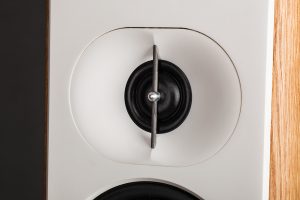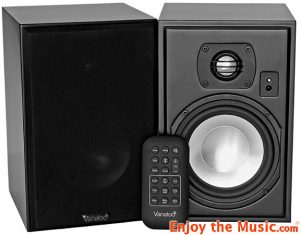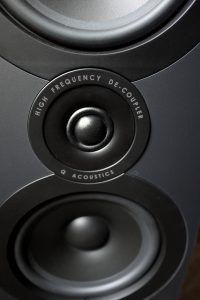Considering the present times and other Pylon Audio products, 23 loudspeakers from the Sapphire series have untypical proportions. If they had been produced a few years ago, that would not have been strange. At that time, almost all loudspeakers offered by Pylon Audio, Monitor Audio and other manufacturers representing the base and medium price ranges looked similar to the tested pair, especially when it comes to their narrow front panel and considerable depth.
Such "column" loudspeakers had been promoted for years as a solution to the problem of "disappearing" from a listening room. It was said that if the width of the front panel is narrower than or close to the distance between the ears of a listener, it is "acoustically" invisible for him or her.
The narrow front was also a move towards lifestyle products. It is because, apart from the actual (or just assumed) advantages, speakers of this type have a light look and are easier to accept for other household members. So, I think that the manufacturer had both of these features in mind.
One of only a few companies that have been seriously involved in the technical aspect of this field is the German company Audio Physic. The loudspeakers that it offers, narrow and deep by definition, with inclined front panels that are supposed to ensure an equal response time of the transducers, also have a special setup procedure. The loudspeakers have to be positioned much further apart from one another than usual, almost at the sides of the listener, and inclined towards him or her (you will find some advice on how to do this HERE). I have taken part in a few well-prepared listening sessions in which such loudspeakers were used and I have to admit that the spatial effects were spectacular. In my opinion, they were not as natural as could be obtained with loudspeakers having wide front panels, but the size of the sound stage, its depth and spatial effects (in the counterphase, for example) were outstanding.
However, there is a problem that has to be faced, since you always have to make choices in audio—it is not possible to fix large woofers onto a narrow front panel, but only a few small ones at the most. Physics is physics and a large surface area of a single speaker is better than the area of many small speakers, even if the latter is, overall, the same as the former. The problem has been dealt with by moving large speakers to the side panel. It can be done, as bass frequencies are all-directional and do not have to be emitted directly onto us to be heard. Of course, there are some issues connected with such an arrangement. Apparently, synchronizing such a speaker with other ones is not that easy. There have been some successful solutions, but even they do not guarantee bass that would be as tangible and full as in the case of classic designs.

SAPPHIRE 23
The sapphire "columns" are 2 1/2 column loudspeakers, with two 130 mm bass-midrange speaker units. That means one of them operates in a full range, working in combination with a dome tweeter, creating a two-way system, like in a monitor. The other speaker is damped in the midrange and supports the other two only when it comes to bass. The transducers are located in a considerably large housing. They operate in combination with a large-diameter bass-reflex system, so a sensible bass foundation can be expected.
However, these are not speakers to be used in large rooms or for playing loud music. Premium models, i.e. Sapphire 25 and 31 serve these purposes. In the case of ‘23’ loudspeakers, Mr. Mateusz Jujka, the CEO of Pylon, talks about rooms of up to 18 – 22 m2 surface area. However, I think that the tested loudspeakers will work best in even smaller rooms, starting from about 15 m2. Finally, it will be possible to furnish small rooms with floor loudspeakers that do not occupy too much space.
A few simple words with…
MATEUSZ JUJKA, CEO
The Sapphire 23, similarly to the larger Sapphire 25, are 2 1/2 column loudspeakers. The idea behind creating this model has been to provide a floorstanding loudspeaker set that would be as compact as possible, allowing it to operate in small rooms. As in all other models from the Sapphire series, we have used a textile tweeter produced by the Norwegian company Seas, while there is also a pair of 13 cm bass-midrange cellulose speaker units manufactured by the German company Visaton.
Smaller bass-midrange speakers make it possible to bring the acoustic centers nearer to one another. Thanks to optimizing the crossover, it is possible for us to use the floorstanding loudspeakers smoothly in conditions in which bookshelf loudspeaker sets are most frequently used. The proposed set of advantages and natural constraints allows us to use the loudspeakers without any problems in rooms of up to 18 – 20 m2 that are relatively large bearing in mind the small size of the Sapphire 23 set.
When it is comes to design, it is similar to other models from the Sapphire series. Here we also have a classic cubic form with characteristic beveled edges of the front panel. The crossover is based on polypropylene capacitors, as well as high-class coils and resistors, mounted, similarly as in the premium models from the Sapphire series, using the point-to-point mounting.
THE LISTENING SESSION
Recordings used for the test (a selection)
- Cantate Domino, performed by the Sistine Chapel Choir conducted by Massimo Palombella, Deutsche Grammophon 479 5300, CD (2015); review HERE
- Adam Bałdych & Helge Lien Trio, Bridges, ACT Music + Vision ACT 9591-2, CD (2015); review HERE
- Carlo Gesualdo, The Complete Madrigals, Delitiae Musicae, Marco Longhini, Naxos 8.507013, 7 x CD (2013)
- Enya, Dark Sky Island, Aigle Music | Warner Music UK/Warner Music Japan WPCR-17045, CD (2015); review HERE
- Jachna, Cichocki, Urowski, Krawczyk, The Right Moment, Requiem Records 99|2015, CD (2015)
- Jamie xx, In Colour, Young Turks/Hostess YTCD122J, CD (2015/2016)
- John Coltrane, Coltrane (Deluxe Edition, Impulse!, 589 567-2, 2 x CD (1962/2002).
- Pink Floyd, The Endless River, Parlophone Records 4621333, CD + Blu-ray (2014).
- Smolik/Kev Fox, Smolik/Kev Fox, Kayax | Agora 92781141, CD (2015)
The Sapphire 23 column loudspeakers are not expensive, but they produce exceptionally good sound. They incorporate all the advantages and disadvantages of this type of loudspeakers, which cannot be avoided. However, the price compensates for the drawbacks and the benefits are considerable.
The loudspeakers really disappear from the equation—they are not present in the room. This is an advantage that small bookshelf loudspeakers are often supposed to have, but equally often lack it. A small size must be accompanied by speaker phase optimization and the speakers must be appropriately "sewn" together. People from the Pylon Audio company have a good sense of hearing, which I have written about many times, so the Sapphire 23 column loudspeakers have all these good features. When we listen to them, it is like listening to a single, but invisible speaker.
One has to get used to their spatial presentation, since at the beginning we do not know what is happening. The speakers generate a large sphere of sound around themselves and around us. They do not identify sound planes and sources precisely, but focus on spatial relations, reverberations, decays and phase shifts. It is a truly holographic message, i.e. the sound stage is deep, but it is not situated BEHIND the loudspeakers. It is everywhere and we are at its centre. The recordings that have seemed to be "good", i.e. recorded without spatial excesses, appear to be more complex, as sounds emerge at unexpected places. We are used to hearing sound at the line of column loudspeakers and behind them, while here we face a presentation in which a large part of the message is also around us, as well as between us and the loudspeakers.
In the case of monophonic material, sound is built up directly in front of us and has a large volume. The precision in focusing the sound plane in front of us is very good. This comes in handy in cases when a sound engineer has placed a vocal a bit closer to us, like in the case of Smolik’s and Kev Fox’s album. However, everything around that central point starts to "go up", as it is not confined to any particular place.
Pink Floyd’s Endless River album starts with a quiet entry. It comes into our room, while we, accompanied by the Pylon column loudspeakers, are agog with anticipation, waiting for what will happen next. After a moment, a speaker’s voice comes out exactly of the left channel. Normally, the voice is chained to a loudspeaker and we know the loudspeaker is standing there. As regards higher-class speaker units, it is different—the voice comes from BEHIND the loudspeaker which seems not to be there at all. When it comes to the Sapphire 23 column loudspeakers, yet something else happens—the voice comes out from behind the loudspeaker, but it is accompanied by considerable reverberation which additionally liberates it from the medium from which the sound is emitted.
The tonal balance has been selected very nicely here. I see people from Pylon Audio quite regularly—we talk to each other, they have listened to my system and they know what my views concerning sound are. I might sound like a megalomaniac now, but who cares: I have an impression that the Pylon Audio loudspeakers have been tuned the way I would tune them, at least when it comes to tone. Perhaps I am wrong, but, anyway, I think that this is a good direction to take and that the price one has to pay for going into another direction is too high. This type of a compromise is better.
Generally speaking, the tonal balance of the tested loudspeakers is close to what Harbeth premium models offer. The Sapphire 23 loudspeakers are not as warm as, for example, series A Splendor loudspeakers or Castle loudspeakers from the Knight series, but they head into this direction. There is no pretending that at such a price you can show the cymbals with their natural attack and vibrancy. Such attempts are generally not successful. Here, the focus is on the connection with the midrange which becomes the most important player. There is no low bass at all and its medium range is not especially deep. However, since the low midrange is dense and saturated, and the transducers are excellently synchronized with one another, I do not care, as these are the reasons why the Pylon loudspeakers sound like a full-range speaker.
They perform very well not only with electronic music and rock, but also with jazz. The first two genres do not have a clear "foundation", so we do not get the rhythmicity that makes us move our body. Such is life. However, the message is consistent and dense, which is just perfect in jazz. I was especially surprised with the albums recorded by the Jachna, Cichocki, Urowski, Krawczyk quartet and Coltrane, where Coltrane performs for the first time with his classical quartet. The surprise was caused by an incredible amount of space (the former album) and lively, dense performance (the latter one). What the loudspeakers lacked a bit in the case of electronic music, i.e. low bass frequencies, did not bother me here at all. The double bass was quite strong and it was very well defined.
Classical music is not the most popular music genre in the world, but, with time, even if we have not got involved in it yet, we listen to more and more of it, on the condition that we become mature and have a specified musical taste. You will see—you will listen to classical music one day, even if it seems abstract to you today. With Sapphire No. 23 you will be prepared to do that better than anyone else, especially if you do not focus your attention on Mahler and twentieth-century experimenters, but on baroque. Try this out now—the space from which the voices of singers reach us when we listen to Cantate Domino, recorded in the Sistine Chapel, will captivate you and everyone around.
These features will also emerge in the case of any other material and make us enthusiastic each time. When we get used to such presentation, any other will seem flat to us, even if it is more natural. The price of this is lower bass saturation and a lack of a solid "foundation" under the sound. The instruments are not precisely focused within their 3D images and they sound more like a live concert, which is not always true. If a microphone was placed close to an instrument, the recorded sound of the instrument is tangible and clear. It is a departure from neutrality, but it is part of the world of recordings and of the art that it constitutes. So, the musical message is always very spatial and it is not tangible, while there is no low bass at all.
Summary
Expecting a lot of bass from such small speaker units does not make sense. However, since there are two speaker units located in a large housing, they might be placed lower in it. However, that would not be the same loudspeaker column and the sound would not be so coherent anymore. So, you must decide yourselves what you are looking for and what you can sacrifice to achieve something else. In this case, you must sacrifice the energy, beat and dense rhythm.
The Sapphire 23 column loudspeakers have a nice and robust design, they are excellently tuned and produce characteristic sound. Give them good surroundings and they will give you twice as much in return—in many respects they will sound like loudspeakers that are two or three times more expensive. The former will not take the place of the latter—that is out of the question—but when it comes to space and coherence, Sapphire No. 23 will impress quite a few designers.
SETUP
Pylon Audio has created column loudspeakers that are valuable enough to make us think of a system in which they would stay for a longer time and would not be replaced, whereas other elements would be changed. I will give you examples of two different systems in which the loudspeakers will find their place.
The first of these systems is based on the Fezz Audio Silver Luna tube amplifier. No. 23 loudspeaker columns are easy to tune, so a tube amplifier is ok here, the more that it is very good and nicely designed. Another element will be the Pro-Ject Primary The Rolling Stones Edition turntable with the Phono Box E preamp from the same manufacturer (a test this month). The result is an outstanding system based on an analogue source. We can expand it by adding a CD player, e.g. the Denon DCD-50 or the Soul Note SA300 and it is going to be beautiful.
The other system is for the people of the 21st century who value design and comfort, but also attach importance to sound. Listen to the Pylon Audio loudspeakers with the PMA-100 (an amp and a streamer in one) and you will never part with this stylish minimalistic system. A Pro-Ject turntable will be a nice addition to it.
The tested loudspeakers are easy to set up, but if we devote more time than usual to them, they will give us better localization and focus. It is all about setting them both up in exactly the same way. Even differences of 10mm to the left, right, front and back change sound. You can buy a laser distance meter and do it yourself (a cost of about 250 PLN), or buy beer and do it with a friend. All you need is inextensible string. You need to hold one of its ends in your hand, while the other end should be held by your friend. You measure the distance from the external edge of the front panel of one of the loudspeakers, mark it on the string (e.g. using sticky tape) and then position the other column loudspeaker in an exactly the same way. Next, you do the same thing with the internal wall. After that you check the external edge once again.
It is worth experimenting, since No. 23 loudspeakers offer us something else in each setup. For me, they worked best quite far away from one another, directed towards me, turned a bit more towards the inside, with axes intersecting at the distance of about 30 cm in front of me. When I sat upright, I could see the thin strip of their external walls.
DESIGN
The Pylon Audio Sapphire 23 are 2 1/2 standalone column loudspeakers with three speaker units each. They are quite high (almost 1 m) and their front panel is very narrow. The housing is covered with artificial veneer, whereas the front is lacquered. Three speaker units are attached to it: a soft SEAS 27TDC dome tweeter (27 mm in diameter) and two Visaton W 130 S bass-midrange speaker units with a tin embossed basket and a paper lacquered membrane (130 mm each). One of them works together with the dome (they are close to one another) and the other one is placed close to the floor. That makes it possible to minimize interference and increases the amount of bass a little. In Pylon Audio’s company documents, both speaker units have the company’s own, not the manufacturers’ labels.
The crossover was assembled using the point-to-point mounting and there are polypropylene capacitors, air coils and a powder core coil in the bass section. Clamps on a flat rating plate also look very nice. Big companies will not provide us with such luxuries, while small manufacturers have to use such means to make up for the difference in their brand perception. The housing is made of MDF board and damped using artificial wool. The bass-reflex outlet is located on the rear panel, at a half of the loudspeaker’s height. The loudspeakers are placed on quite high spikes and they are not equipped with grilles.
These are very well-made, nice column loudspeakers having a well-thought-out design.
Technical specifications (according to the manufacturer):
- Nominal impedance: 4 Ω
- Frequency response: 45 Hz – 20 Hz
- Nominal power: 80 W
- Maximum power: 160 W
- Efficiency: 87 dB
- Dimensions [W x H x D]: 160 x 980 x 270 mm
- Weight: 14.5 kg/unit
- Bass-midrange speaker unit: 2 x Pylon Audio PSW 13-80.8
- Tweeter: Pylon Audio PST T-120.6 (Seas 27TDC)
- Bass-reflex housing
- Warranty: 3 years + 1 year (product registration)
- Available colors: black, hazel, wenge, HG white, HG black. Natural veneer: wenge, black, hazel, cherry. The company also offers customized design solutions (RAL colors).
SAPPHIRE 23
Price (in Poland): 2490 PLN/pair
PYLON S.A.
ul. Wrocławska 77 | 63-200 Jarocin
Poland
http://www.pylonaudio.pl
MADE IN POLAND
Text: Wojciech Pacuła
Photos: Wojciech Pacuła
Translation: Ewa Muszczynko












































